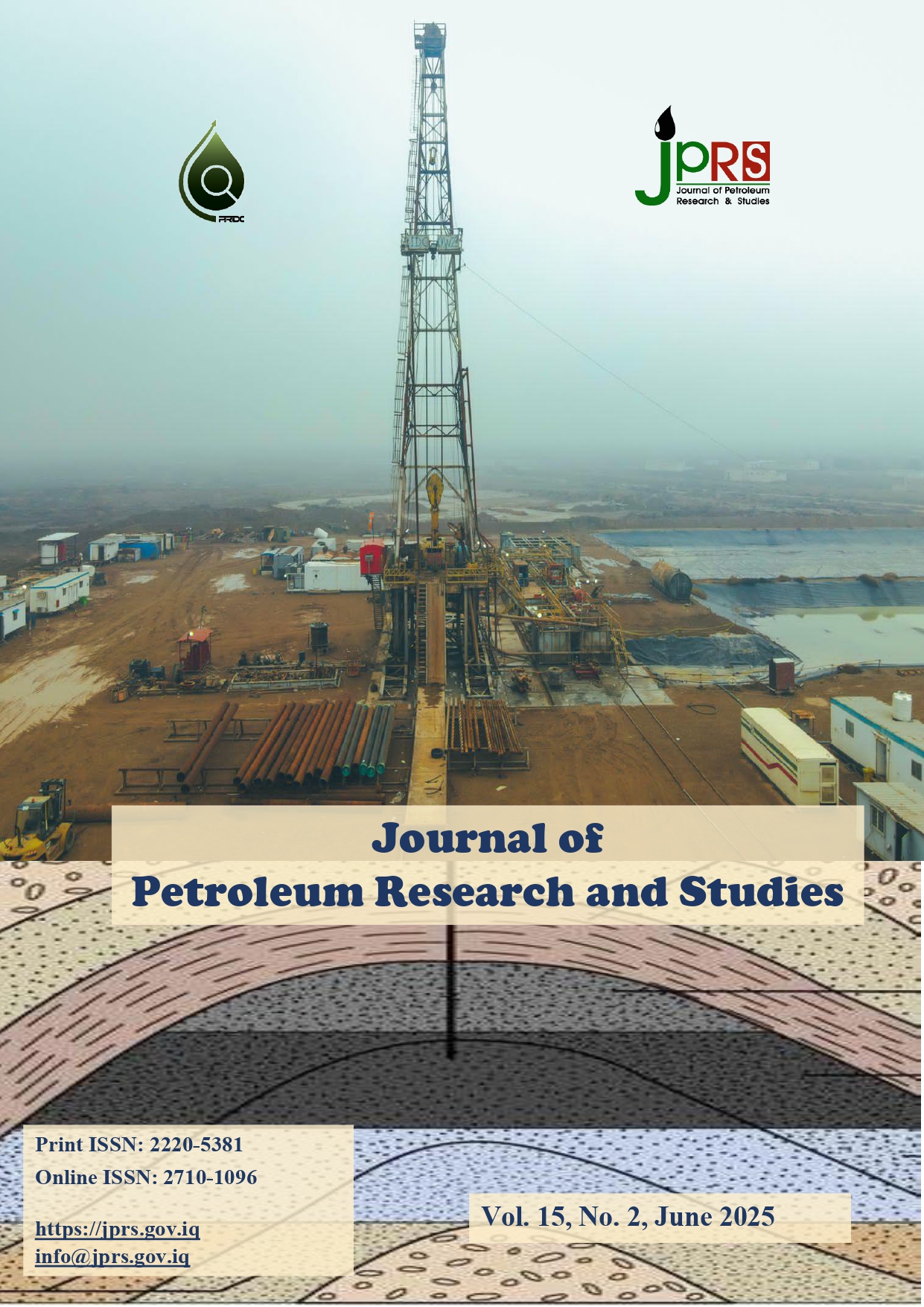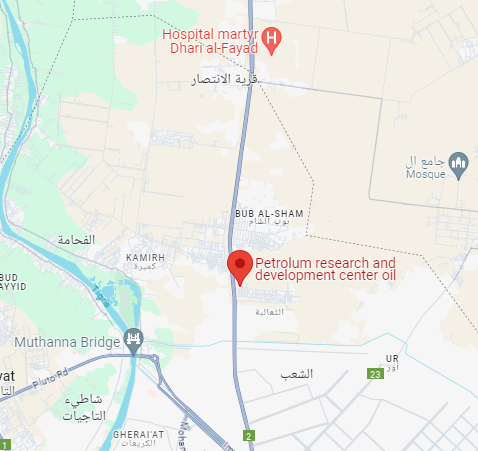التدرجات الحرارية الأرضية في العراق مستنتجة من درجات حرارة البئر
DOI:
https://doi.org/10.52716/jprs.v15i2.986الكلمات المفتاحية:
درجة حرارة البئر، التدرج الحراري الأرضي، توليد الحرارة، الصخر الطفل،الملخص
يعد التدرج الحراري الجوفي أداة مهمة في التنقيب عن البترول وحاسمة للعديد من تقييمات المكامن. تم استخدام بيانات درجات الحرارة في ٤٨ بئراً لتحديد الاتجاه الحراري الأرضي في العراق.
تكون درجة الحرارة المسجلة لأباراقل من درجة الحرارة الحقيقية. وبالتالي، تم استخدام مخطط هورنر في هذه الدراسة لتصحيح درجات الحرارة الأبار حيث سيتم رسم درجة الحرارة المبلغ عنها عند عمق محدد مقابل وقت إعادة التدفئة.
تختلف التدرجات الحرارية الأرضية بشكل ملحوظ أفقيًا (من بئر إلى بئر) وعموديًا (العمق). يعتبر التناقض في التدرجات الحرارية الأرضية في جميع أنحاء المنطقة المدروسة هي نتيجة لتنوع التوصيل الحراري للرواسب واتجاه تدفق المياه الجوفية ونمط الصدوع وتوليد الحرارة.
وجد في شمال العراق أن أعلى انحدار جيوحراري هو ٢٩٬٢ درجة مئوية/ كم في بئر بطمة -٢ في نطاق الطيات الواطئة. ولوحظ أن أدنى التدرجات الحرارية الأرضية هي ١٤٬٩ درجة مئوية/ كم في بئر زيوي - ١ في منطقة نطاق الطيات العالية. ولوحظ أيضا أن متوسط التدرج الجيوحراري الإقليمي لكردستان العراق هو ٢١ درجة مئوية/ كم. في وسط العراق، يبلغ متوسط التدرج الحراري الأرضي حوالي ٢٠ درجة مئوية/ كم بناءً على المناطق المجاورة. في جنوب العراق، وجد أن أعلى انحدار جيوحراري هو ٢٩٬٧درجة مئوية/ كم في بئر نهر عمر -٧ في منطقة نطاق الزبير. كما لوحظ بأن أدنى التدرجات الحرارية الأرضية هي ١٦٬٧ درجة مئوية/ كم في بئر لوهيس-٢ في منطقة نطاق الزبير وأن متوسط التدرج الجيوحراري الإقليمي لجنوب العراق هو ٢٢٬٢ درجة مئوية/ كم. أما في الصحراء الغربية فان أدنى انحدار ضمن الوحدات فوق الباليوزويك هو ١٢٬٢ درجة مئوية/ كم في البئر KH-9/7 الكائن في الجزء الشرقي من المنطقة داخل منطقة نطاق الرطبة وأعلى قيمة كانت ٣١٬٣ درجة مئوية/ كم في بئر عكاس-١ في الجزء الشمالي الغربي من المنطقة داخل نطاق الجزيرة. حيث تم تسجيل أعلى تدرج للطاقة الحرارية الأرضية وهو ٦١ درجة مئوية/ كم داخل وحدات الباليوزويك و داخل تكوين عكاس في عمق ٢١٠٠-٢٣٥٠ متر تحت السطح. وكان متوسط التدرج الحراري الأرضي في الصحراء الغربية هو ٢٦ درجة مئوية/ كم داخل الوحدات الأحدث من العصر الباليوزوي، ولكن هذا المتوسط يرتفع إلى ٤٠ درجة مئوية/ كم داخل وحدات عصر الباليوزويك بسبب وجود صخور السيلوري وتدفق الحرارة من ترسبات البروتيروزويك.
المراجع
C.N. Nwankwo, “Heat flow studies and hydrocarbon maturation modeling in the Chad Basin, Nigeria”, Ph. D. Thesis (unpublished), University of Port Harcourt, PortHarcourt, Nigeria, pp. 1–45, 2007.
P. Dotsey, “New approach to basin formation temperature modeling”, First Break, vol. 30, pp. 107–113, 2012. https://doi.org/10.3997/1365-2397.30.12.65624.
M.W. Ibrahim, “Petroleum geology of southern Iraq”, AAPG Bulletin, vol. 67, no. 1, pp. 97–130, 1983.
M. H. El Zarka, “Ain Zalah Field, Iraq: Zagros Folded Zone, northern Iraq”, in TR: Structural Traps VIII, The AAPG/ Special Volumes, pp. 57–68, 1993.
S. Al-Shdidi, G. Thomas, and J. Delfaud, “Sedimentology, diagenesis and oil habitat of lower Cretaceous Qamchuqa Group, northern Iraq”, AAPG Bulletin, vol. 79, no. 5, pp. 763–779, 1995. https://doi.org/10.1306/8D2B1B9C-171E-11D7-8645000102C1865D.
J.K. Pitman, D. Steinshouer, and M.D. Lewan, “Petroleum generation and migration in the Mesopotamian Basin and Zagros Fold Belt of Iraq: Results from a basin-modeling study”, GeoArabia, Gulf PetroLink, Bahrain, vol. 9, no. 4, pp. 41–72, 2004. https://doi.org/10.2113/geoarabia090441.
S. Z. Jassim and M. Al-Gailani, “Hydrocarbons”, chapter 18, in Geology of Iraq, first edition, Brno, Czech Republic, Prague and Moravian Museum, pp. 232–250, 2006.
A. A. M. Aqrawi, J. C. Goff, A. D. Horbury and F.N. Sadooni, “The Petroleum Geology of Iraq”, Scientific Press, Bucks, UK, 2010.
Q. Abeed, R. Littke, F. Strozyk, and A. K. Uffmann, “The upper Cretaceous petroleum system of southern Iraq: A 3D basin modeling study”, GeoArabia, Gulf PetroLink, Bahrain, vol.18, no. 1, pp. 179–200, 2013. https://doi.org/10.2113/geoarabia1801179.
R. A. Abdula, “Oil and Gas Generation History Based On Burial History Reconstruction and Thermal Maturity Modeling of Petroleum Systems in Northern Iraq”, Journal of Petroleum Research and Studies, vol. 10, no. 4, pp. 95-120, Dec. 2020. https://doi.org/10.52716/jprs.v10i4.370
R. A. Abdula, R. A., “Geothermal gradients in Iraqi Kurdistan deduced from bottom hole temperatures”, Egyptian Journal of Petroleum, vol. 26, no. 3, pp. 601–608, 2017. https://doi.org/10.1016/j.ejpe.2016.08.007.
R. A. Abdula, A. S. Al-zubedi, and H. Hashmi, “Abnormality of geothermal gradients in Iraqi western desert inferred from borehole temperatures”, IOP Conference Series, Earth and Environmental Science, vol. 1080, 012010, pp. 1–9, 2022. https://doi.org/10.1088/1755-1315/1080/1/012010.
F. Ahmadhadi, J. Daniel, M. Azzizadeh, and O. Lacombe, “Evidence for pre-folding vein development in the Oligo-Miocene Asmari Formation in the Central Zagros Fold Belt, Iran”, Tectonics, vol. 27, no. 1, pp. 1–22, 2007. https://doi.org/10.1029/2006TC001978.
M. S. Ameen, “Effect of basement tectonics on hydrocarbon generation, migration, and accumulation in northern Iraq”, AAPG Bulletin, vol. 76, no. 3, pp. 356–370, 1992. https://doi.org/10.1306/BDFF87FE-1718-11D7-8645000102C1865D.
K. Hessami, H. A. Koyi, and C.J. Talbot, “The significance of strike-slip faulting in the basement of the Zagros fold and thrust belt”, Journal of Petroleum Geology, vol. 241, no 1, pp. 5–28, 2001. https://doi.org/10.1111/j.1747-5457.2001.tb00659.x.
S. F. A. Fouad, “Tectonic map of Iraq, scale 1:1000 000”, 3rd edition, IBGM/ Iraqi Bulletin of Geology and Mining/ Iraq Geological Survey, Baghdad, Iraq, 2012.
S. Z. Jassim and T. Buday, “Units of the Stable Shelf”, chapter 5, in Geology of Iraq, first edition, Brno, Czech Republic, Prague and Moravian Museum, pp. 57–70, 2006b.
I. Q. Mohammed, “The geology and economic potential of mineral deposits and occurrences of Iraq”, IBGM, special issue, no.8, pp. 175–202, 2019.
V. K. Sissakian and B. S. Mohammed, “Stratigraphy”, Iraqi Bulletin of Geology and Mining, special issue, Geology of Iraqi Western Desert, pp. 51–124, 2007.
E. M. S. Al-Heety, M. A. Al-Mufarji and L. H. Al-Esho, “Qualitative interpretation of gravity and aeromagnetic data in west of Tikrit City and surroundings, Iraq”, International Journal of Geosciences, vol. 8, pp. 151–166, 2017. https://doi.org/10.4236/ijg.2017.82005.
C. N. Nwankwo and A. S. Ekine, “Geothermal gradients in the Chad Basin, Nigeria from bottom hole temperature logs”, Inter. J. of Phys. Sc., vo. 4, no. 12, pp. 777–783, 2009.
W. L. Dowdle and W. M. Cobb, “Static formation temperature from well logs: An empirical method”, J. Petrol. Tech., vol. 27, pp. 1326–1330, 1975. https://doi.org/10.2118/5036-PA.
J. Forrest, E. Marcucci, and P. Scott, “Geothermal gradients and subsurface temperatures in the northern Gulf of Mexico”, GCAGS Transactions, vol. 55, pp. 233–248, 2005.
B. S. D. Sonam and V. Kumar, “Trend of geothermal gradient from bottom hole temperature studies in South Cambay Basin (Narmada Broach Block)”, 10th Biennial International Conference and Exposition, vol. 386, 2013.
C. N. Nwankwo, A. S. Ekine, and L. I. Nwosu, “Estimation of the heat flow variation in the Chad Basin, Nigeria”, Journal of Applied Sciences and Environment Management, vol. 13, no. 1, pp. 73–80, 2009. https://doi.org/10.4314/jasem.v13i1.55276.
P. T. Negraru, D. D. Blackwell, and K. Erkan, K., “Heat flow and geothermal potential in the South-Central United States”, Natural Resources Research, vol. 17, no. 4, pp. 227–243, 2007. https://doi.org/10.1007/s11053-008-9081-x.
IOM, “Atlas of climate of Iraq for the years (1981–2000)”, Iraqi Organization for Meteorological Information, Baghdad, Iraq, 2000.
K.H. Al-Jiburi and N.H. Al-Basrawi, “Hydrogeology”, Iraqi Bulletin of Geology and Mining, Special Issue, Geology of Iraqi Western Desert, pp. 125–144, 2007.
S. Z. Jassim and T. Buday, “Tectonic framework,” chapter 4, in Geology of Iraq, first edition, Brno, Czech Republic, Prague and Moravian Museum, pp. 45–56, 2006a.
H. A. Al-Dabagh, “Qualitative interpretation of regional radiometric airborne survey for Gaa’ra-Higher Euphrates Region (Western Iraq)”, unpublished PhD Dissertation, College of Science, University of Baghdad, Iraq, 1999.
F. M. Q. Majidee, “The reasons of high temperature in well Akkas-1 and its effect on maturation’s time of source rocks”, Master’s thesis (unpublished), Science College, University of Baghdad, Baghdad, Iraq, 1999.
Z. R. Beydoun, A. R. I. Futyan, and A. H. Jawzi, “Jordan revisited: Hydrocarbons habitat and potential”, Journal of Petroleum Geology, vol. 17, pp. 177–194, 1994. https://doi.org/10.1111/j.1747-5457.1994.tb00125.x
A. Swarieh, “Geothermal energy resources in Jordan, country update report”, Proceedings World Geothermal Geothermal Congress, Kyushu - Tohoku, Japan, May 28 - June 10, pp. 469-474, 2000.
S. Al-Zyoud, “Shallow Geothermal energy resources for future utilization in Jordan”, Open Journal of Geology, vol. 9, no. 11, pp. 783-794, 2019. https://doi.org/10.4236/ojg.2019.911090
H. A. Armstrong, B. R. Turner, I. M. Makhlouf, G. P. Weedon, M. Williams, A. Al Smadi, and A. Abu Salah “Origin, sequence stratigraphy and depositional environment of an upper Ordovician (Hirnantian) deglacial black shale, Jordan”, Palaeogeography, Palaeoclimatology, Palaeoecology, vol. 220, no. 2-3, pp. 273–289, 2005. https://doi.org/10.1016/j.palaeo.2005.01.007.
G. R. Beardsmore and J.P. Cull, “Crustal heat flow: A guide to measurement and modeling”, Press Syndicate of the University of Cambridge, Pitt Building, Trumpington Street, Cambridge, United Kingdom, 2001.
I. Q. Mohammed, “Petrology and geochemistry of upper Cretaceous–Paleocene phosphatic rocks in the Rutbah–H3 area, western Desert of Iraq”, Master’s thesis (unpublished), Science College, University of Baghdad, Baghdad, Iraq, 1985.
I. Q. Mohammed, Mineralogy, “Petrology and depositional environment of clays and siliciceous rocks in the Maastrichtian–Danian sequence in western Iraq”, Ph.D. Thesis (unpublished), Science College, University of Baghdad, Baghdad, Iraq, 1993.
Kh.S. Al-Bassam, “Uranium in the Iraqi phosphorites," Iraqi Bulletin of Geology and Mining, vol. 3, no. 2, pp. 13–31, 2007.
A. Saffarzadeh and Y. Noorollahi, “Geothermal development in Iran: A country update,” Proceedings World Geothermal Congress, Antalya, Turkey, 24-29 April 2005, pp. 1-7, 2005.
Y. Noorollahi, H. Yousefi, S. Ehara, R. Itoi, “Geothermal energy development in Iran,” proceedings of The Direct Heating Use of Geothermal Resources in Asia Workshop, organized by UNU-GTP, TBLRREM and TBGMED, in Tianjin, China, 11-18 May, 2008.
V. K. Sissakian1, A. D. Abdul Ahad, N. Al-Ansari, and S. Knutsson, “Geomorphology, Geology and Tectonics of Jabal Sanam, Southern Iraq”, Journal of Earth Sciences and Geotechnical Engineering, vol. 7, no. 3, pp. 97-113, 2017.
J. Raymond, H. Langevin, F. Comeau, and M. Malo, “Temperature dependence of rock salt thermal conductivity: Implications for geothermal exploration”, Renewable Energy, vol. 184, pp. 26-35, 2022. https://doi.org/10.1016/j.renene.2021.11.080.
M. W. Ibrahim, “Geothermal gradients and geothermal oil generation in southern Iraq: A preliminary investigation”, Journal of Petroleum Geology, vol. 7, no. 1, pp. 77–86, 1984. https://doi.org/10.1111/j.1747-5457.1984.tb00163.x.
M.A. Einstein, V. Cesar, and A. Al Saffar, A., “Abnormal temperature gradient in north Kuwait: A case study”, Paper presented at the SPE/IATMI Asia Pacific Oil & Gas Conference and Exhibition, Nusa Dua, Bali, Indonesia, Paper Number: SPE-176287-MS, October 2015. https://doi.org/10.2118/176287-MS
التنزيلات
منشور
كيفية الاقتباس
إصدار
القسم
الرخصة
الحقوق الفكرية (c) 2025 Rzger Abdulkarim Abdula, Kambale Kavyavu Wisdom

هذا العمل مرخص بموجب Creative Commons Attribution 4.0 International License.














